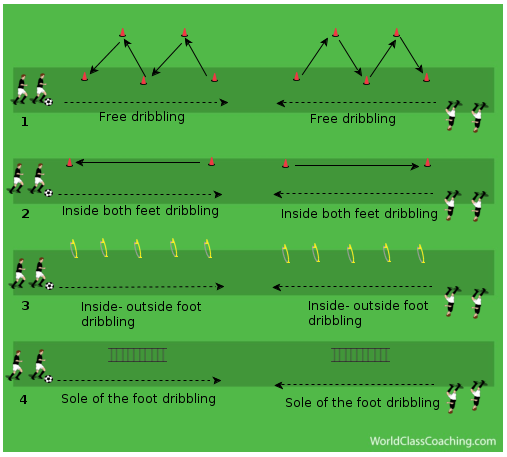by Gabriel Celante
This drill helps to improve anaerobic and aerobic capacity, speed with and without the ball as well as accuracy passing, timing, first touch, and dribbling with all parts of the foot.
Organization
- Line up partners facing each other with a ball.
- Partners should be spaced 30 meters apart.
- Set up four different variations as shown in the diagram
- Each partner should have an agility exercise by their sides as shown in the diagram.
Instructions
- Each partner (or group) work for three-four minutes before switching to the next variation.
- 30-45 seconds interval to rotate between variations.
- Partners should maintain their spacing at all times.
Variation 1
Player A dribbles the ball (Free dribbling) for 15 meters, makes a pass to Player B, performs an agility exercise (Zig-Zag Sprinting), and comes back to his original position. Player B does the same thing and continues the rotation.
Variations 2
Player A dribbles the ball (Inside both feet dribbling) for 15 meters, makes a pass to Player B, performs an agility exercise (Backward Sprinting), and comes back to his original position. Player B does the same thing and continues the rotation.
Variation 3
Player A dribbles the ball (inside-outside foot dribbling) for 15 meters, makes a pass to Player B, performs an agility exercise (Jumping forward over hurdles), and comes back to his original position. Player B does the same thing and continues the rotation.
Variation 4
Player A dribbles the ball (Sole of the foot dribbling) for 15 meters, make a pass to Player B, performs an agility exercise (Agility on the speed later), and comes back to his original position. Player B does the same thing and continues the rotation.
Coaching Points
- Focus on the quality of passes such as weight, pace, and accuracy.
- Focus on first touch.
- Dribbling players should dribble with speed but keeping the ball under control.
- Ensure quality of movements.
- Work hard even when tired.
By Gabriel Celante. Celante has worked at Ituano Futebol Clube and E.C. XV Piracicaba, two professional clubs in his native Brazil as a soccer conditioning specialist. Celante now works for BRASA (Brazilian Soccer Academy) in NJ.



